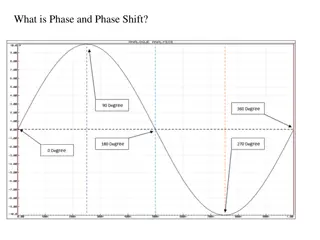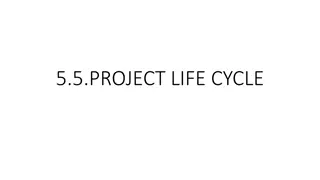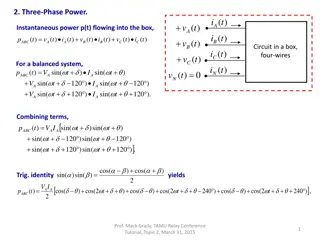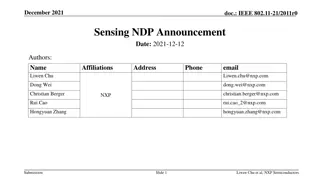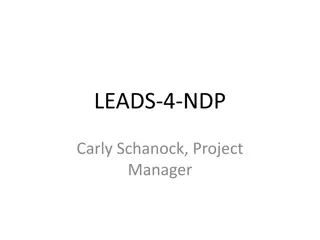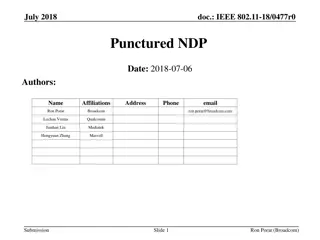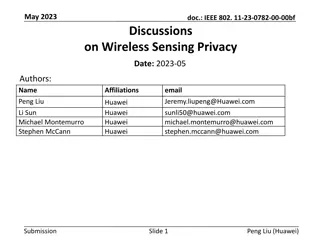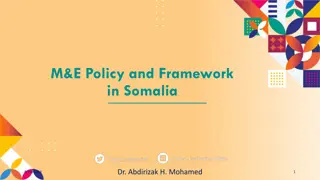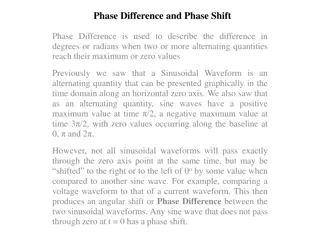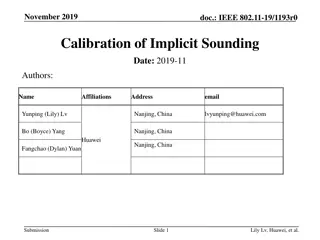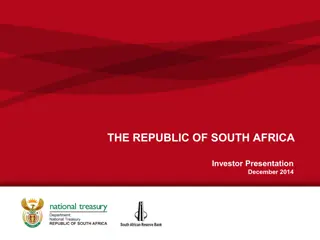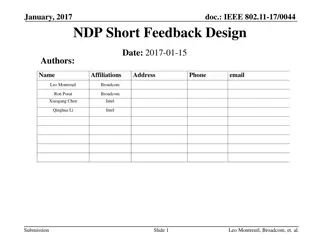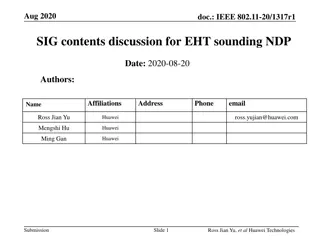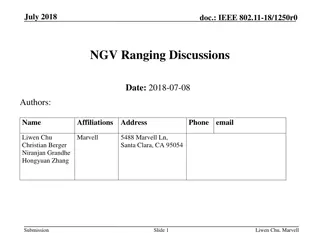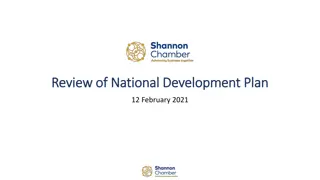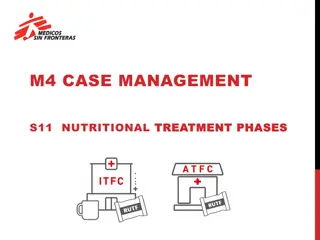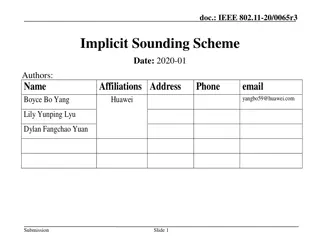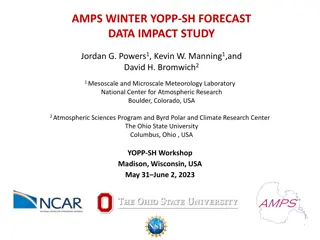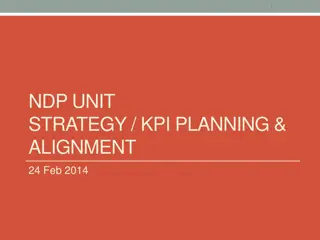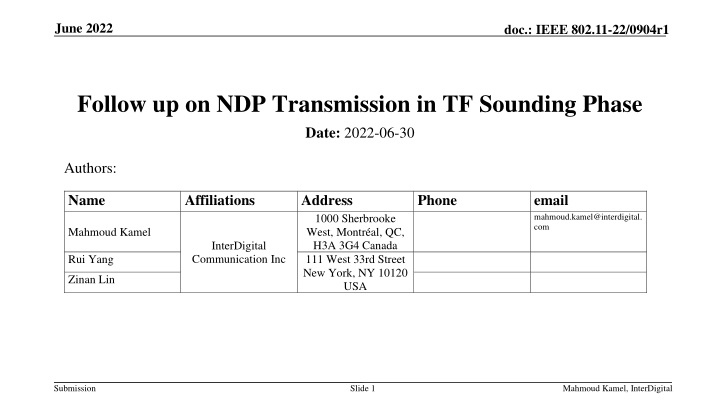
Methods for Multiplexing NDP Transmission in TF Sounding Phase
Explore the various methods for multiplexing NDPs from responder transmitters in the TF sounding phase of the TB Measurement Instance in IEEE 802.11-22/0904r1. Analyze the pros and cons of multiplexing NDPs in the spatial and frequency domains, along with insights on triggering multiple responders in one TXOP.
Download Presentation

Please find below an Image/Link to download the presentation.
The content on the website is provided AS IS for your information and personal use only. It may not be sold, licensed, or shared on other websites without obtaining consent from the author. If you encounter any issues during the download, it is possible that the publisher has removed the file from their server.
You are allowed to download the files provided on this website for personal or commercial use, subject to the condition that they are used lawfully. All files are the property of their respective owners.
The content on the website is provided AS IS for your information and personal use only. It may not be sold, licensed, or shared on other websites without obtaining consent from the author.
E N D
Presentation Transcript
June 2022 doc.: IEEE 802.11-22/0904r1 Follow up on NDP Transmission in TF Sounding Phase Date: 2022-06-30 Authors: Name Affiliations Address 1000 Sherbrooke West, Montr al, QC, H3A 3G4 Canada 111 West 33rd Street New York, NY 10120 USA Phone email mahmoud.kamel@interdigital. com Mahmoud Kamel InterDigital Communication Inc Rui Yang Zinan Lin Submission Slide 1 Mahmoud Kamel, InterDigital
June 2022 doc.: IEEE 802.11-22/0904r1 Abstract In a previous contribution [1], we discussed several methods for how the NDPs may be multiplexed from responder transmitters in the TF sounding phase of the TB Measurement Instance In this contribution, we follow up on the discussion and show the pros and cons of multiplexing the NDPs in the spatial domain and the frequency domain. We also show an analysis of how many responders may be triggered in one TXOP Submission Slide 2 Mahmoud Kamel, InterDigital
June 2022 doc.: IEEE 802.11-22/0904r1 Recap of TF Sounding Phase TB Measurement Instance[2] In TF Sounding phase: The AP shall transmit a Sensing Sounding TF to solicit R2I NDP transmissions The Sensing Sounding Trigger frame shall allocate uplink resources for one or more STA s R2I NDP transmission covering the full bandwidth NOTE If the number of available sensing transmitters exceeds the available uplink resources, multiple sequential trigger frames can be transmitted within the acquired TXOP Submission Slide 3 Mahmoud Kamel, InterDigital
June 2022 doc.: IEEE 802.11-22/0904r1 Methods to Transmit R2I NDP in TF Sounding Phase Method 1: Sensing Responder Transmitters transmit the NDP sequentially The NDP PPDU covers the full bandwidth Method 2: Sensing Responder Transmitters transmit the NDP parallelly a) The NDP PPDUs are sent at the same time and multiplexed in the spatial domain b) The NDP PPDUs are sent at the same time and multiplexed in the frequency domain Method 3: Sensing Responder Transmitters transmit the NDP parallelly The NDP PPDUs are sent at the same time using the same frequency and spatial resource Method 4: Combination of Methods 1-3 Submission Slide 4 Mahmoud Kamel, InterDigital
June 2022 doc.: IEEE 802.11-22/0904r1 Methods to Transmit R2I NDP in TF Sounding Phase Spatial TF TF TF TF TF SIFS SIFS SIFS SIFS SIFS Time Initiator NDP1 NDP3 NDP2 NDP1 NDP1 NDP2 NDP3 NDP2 NDP1 NDP2 NDP3 Responder Txs Method 1 Method 2a Method 2b Method 3 Submission Slide 5 Mahmoud Kamel, InterDigital
June 2022 doc.: IEEE 802.11-22/0904r1 Methods to Transmit R2I NDP in TF Sounding Phase Spatial TF TF TF TF TF SIFS SIFS SIFS SIFS SIFS Time Initiator NDP1 NDP3 NDP2 NDP1 NDP1 NDP2 NDP3 NDP2 NDP1 NDP2 NDP3 Responder Txs Method 1 Method 2a Method 2b Method 3 Submission Slide 6 Mahmoud Kamel, InterDigital
June 2022 doc.: IEEE 802.11-22/0904r1 Method 2a (Spatial Domain Multiplexing) - Pros Provides a simple way to multiplex multiple NDPs in the uplink This mode of multiplexing the NDP transmission has been specified in 11az The HE TB NDP format is defined and no additional PHY changes are needed to enable this mode Would allow up to 8 responder transmitters to transmit NDPs simultaneously Assuming that the number of the receive antennas at the initiator AP is 8 In case of large number of responders, the initiator AP may need to solicit the NDP transmission in multiple triggering sequences Submission Slide 7 Mahmoud Kamel, InterDigital
June 2022 doc.: IEEE 802.11-22/0904r1 Method 2a (Spatial Domain Multiplexing) - Cons TXOP duration will limit the number of responder transmitters that can be triggered Long TXOP duration for sensing may be not desirable for communication services and would disrupt other traffic in the BSS such as low latency traffic In a later contribution, we may discuss how long should be the TXOP duration for sensing Limit the use of the available bandwidth if any of the responder transmitters is 20 or 80 MHz operating STAs The initiator AP needs to set the UL BW of the Common field of the trigger frame in the TF Sounding phase to a single value All responders shall use the same bandwidth when transmitting their NDPs We may need to group the responders based on their operating bandwidth and trigger each group in one triggering sequence Submission Slide 8 Mahmoud Kamel, InterDigital
June 2022 doc.: IEEE 802.11-22/0904r1 Numerical Analysis TB Measurement Instance Phases In this numerical analysis, we estimate how many responders may be triggered in one TXOP Only Polling phase and TF Sounding phase are considered. SIFS SIFS ????????= ?? ??+ ???? ?? ????+ 2???? Polling Phase Polling TF CTS-to-Self NDPA Sounding Phase SIFS SIFS ?????_?= ?????+ ??2? ???+ 2???? NDPA I2R-NDP TF Sounding Phase SIFS SIFS ???_?= ?? ??+ ??2? ???+ 2???? Sounding TF R2I-NDP Reporting Phase SIFS SIFS ?????????_?= ?? ??+ ???????+ 2???? Reporting TF Report Submission Slide 9 Mahmoud Kamel, InterDigital
June 2022 doc.: IEEE 802.11-22/0904r1 Method 2a Numerical Analysis (Polling Phase) Numerical Analysis Parameters Number of Polled Responders: 8 responders CTS Frame MCS: QPSK 1/2 Time needed for the Polling phase is ??? ? sec. Polling phase time bounds: The minimum time is 120 ? sec. CTS Frame MCS: 64QAM 3/4 The maximum time is 192 ? sec. CTS Frame MCS: BPSK 1/2 Submission Slide 10 Mahmoud Kamel, InterDigital
June 2022 doc.: IEEE 802.11-22/0904r1 Method 2a Numerical Analysis (TF Sounding Phase) Numerical Analysis Parameters Number of Responder Transmitters: 8 responders Number of LTFs: 1 LTF LTF Repetitions: 8 repetitions Trigger Frame MCS: QPSK 1/2 Time needed for the TF Sounding phase is ??? ? sec TF Sounding phase time bounds The minimum time is 192 ? sec LTF Repetitions = 1 Trigger Frame MCS: 64QAM 3/4 The maximum time is 712 ? sec LTF Repetitions = 8 Trigger Frame MCS: BPSK 1/2 Submission Slide 11 Mahmoud Kamel, InterDigital
June 2022 doc.: IEEE 802.11-22/0904r1 Method 2a Numerical Analysis (Number of Responders) Numerical Analysis Parameters TXOP = 4096 ? s Polling phase time (????????) = 152 ? s TF Sounding phase time (???_?) = 672 ? s Number of Polling phases(????????)= ? Total Number of polled responders = ?? In one TXOP, there may be multiple Polling phases and multiple TF Sounding phases ????? ???????? ????????+ ???_? ???_? The maximum number of Responders in TF Sounding (???_?,??? ) may then be computed as ???_?,??? = ?? ?????????? Submission Slide 12 Mahmoud Kamel, InterDigital
June 2022 doc.: IEEE 802.11-22/0904r1 Method 2a Numerical Analysis The NDPA Sounding phase and the Reporting phase are not considered in the analysis If the NDPA Sounding phase and the Reporting phase are both taking place in the same TXOP, this would reduce the time available for the TF Sounding phase, and hence the number of Responder transmitters participating in the TF Sounding phase Submission Slide 13 Mahmoud Kamel, InterDigital
June 2022 doc.: IEEE 802.11-22/0904r1 Method 2b (Frequency Domain Multiplexing) - Pros EHT Trigger frames may support partial bandwidth allocation Up to 8 users can be multiplexed on 320 MHz (Each user will be allocated 40 MHz) The sensing operation over a smaller bandwidth may provide coarse sensing results Punctured channel sensing may be supported Sensing on larger bandwidths is desirable Submission Slide 14 Mahmoud Kamel, InterDigital
June 2022 doc.: IEEE 802.11-22/0904r1 Method 2b (Frequency Domain Multiplexing) - Cons Requires Support for Uplink OFDMA NDP 11az does not support OFDMA NDP Uplink OFDMA NDP is not defined yet in 11ax and 11be Multiple low-end devices (20 MHz-only STAs) cannot be triggered to send the NDP multiplexed in the frequency domain since all the 20 MHz-only STAs will be operating on the same primary channel of the BSS There are many restrictions for the allowed RUs for 20 MHz operating non-AP STAs in EHT [3] Submission Slide 15 Mahmoud Kamel, InterDigital
June 2022 doc.: IEEE 802.11-22/0904r1 A Comparison between Method 2a and Method 2b Method 2a Method 2b Multiplexing Legacy Use Support in the Standard Space Domain Frequency Domain HE TB Ranging NDP Not used in the current standard Supported Not Supported Simplicity Supported in the specs Allows multiple responders (up to 8) to transmit their NDPs concurrently Support of punctured channel sensing May be supported by EHT NDP and TF Pros Complex allocation of uplink resources Limited number of sensing responders in the same TXOP Less sensing accuracy (smaller bandwidth is used for sensing) Not supported in the current specs Power Control Limited number of sensing responders in the same TXOP Limit the use of the available bandwidth Cons Submission Slide 16 Mahmoud Kamel, InterDigital
June 2022 doc.: IEEE 802.11-22/0904r1 Conclusions Multiplexing the NDP in Spatial domain or Frequency domain is discussed and the pros and cons of each scheme are presented The numerical analysis shows that a limited number of responder transmitters may participate in the TF Sounding phase in one TXOP Better techniques are required to improve the sensing efficiency in the TF Sounding phase Submission Slide 17 Mahmoud Kamel, InterDigital
June 2022 doc.: IEEE 802.11-22/0904r1 SP 1 Do you agree that in TF Sounding phase, considering scenarios with large number of responders determined in the association, the TXOP duration will limit the number of Responder transmitters that can be triggered in the TF Sounding phase considering Method 2a in Slide 5. a) Yes b) No c) Abstain Submission Slide 18 Mahmoud Kamel, InterDigital
June 2022 doc.: IEEE 802.11-22/0904r1 References [1] 802.11-22/0654r0, Discussion on NDP Transmission in TF Sounding Phase, April 2022. [2] IEEE P802.11bf /D0.01, Amendment 2: Enhancements for WLAN Sensing , March 2022. [3] IEEE P802.11be /D2.0, Amendment 8: Enhancements for extremely high throughput (EHT) , March 2022. Submission Slide 19 Mahmoud Kamel, InterDigital
June 2022 doc.: IEEE 802.11-22/0904r1 Trigger Frame Format Submission Slide 20 Mahmoud Kamel, InterDigital
June 2022 doc.: IEEE 802.11-22/0904r1 CTS-to-Self Submission Slide 21 Mahmoud Kamel, InterDigital
June 2022 doc.: IEEE 802.11-22/0904r1 HE TB Ranging NDP Format Submission Slide 22 Mahmoud Kamel, InterDigital
June 2022 doc.: IEEE 802.11-22/0904r1 Non-HT Packet Structure Submission Slide 23 Mahmoud Kamel, InterDigital
June 2022 doc.: IEEE 802.11-22/0904r1 TXTIME for HE Ranging NDP Submission Slide 24 Mahmoud Kamel, InterDigital
June 2022 doc.: IEEE 802.11-22/0904r1 TXOP Limits Submission Slide 25 Mahmoud Kamel, InterDigital
June 2022 doc.: IEEE 802.11-22/0904r1 Polling Phase of TB Ranging Submission Slide 26 Mahmoud Kamel, InterDigital

